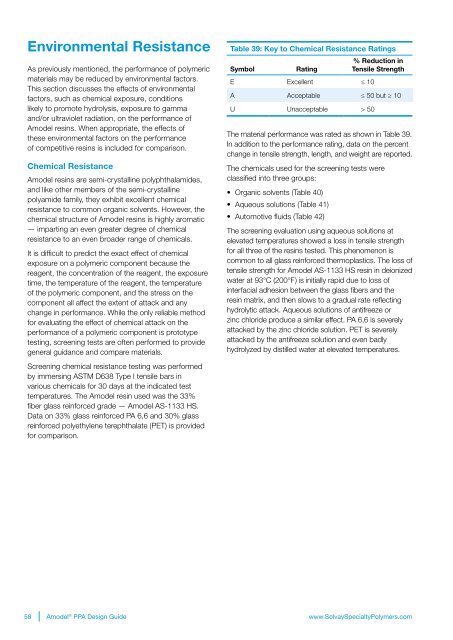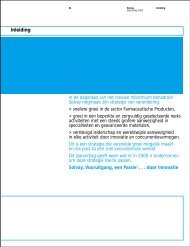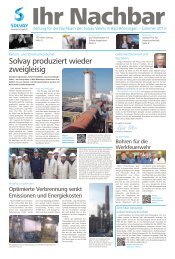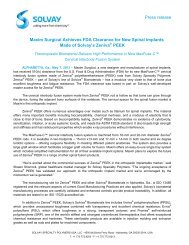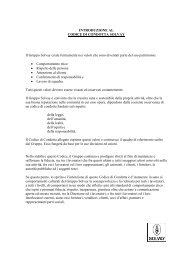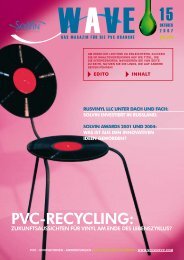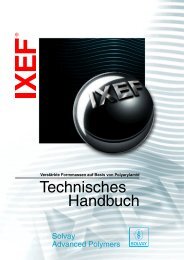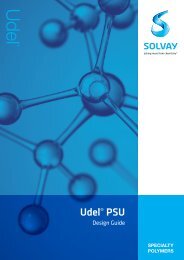Design Guide - Solvay Plastics
Design Guide - Solvay Plastics
Design Guide - Solvay Plastics
You also want an ePaper? Increase the reach of your titles
YUMPU automatically turns print PDFs into web optimized ePapers that Google loves.
Environmental Resistance<br />
As previously mentioned, the performance of polymeric<br />
materials may be reduced by environmental factors.<br />
This section discusses the effects of environmental<br />
factors, such as chemical exposure, conditions<br />
likely to promote hydrolysis, exposure to gamma<br />
and/or ultraviolet radiation, on the performance of<br />
Amodel resins. When appropriate, the effects of<br />
these environmental factors on the performance<br />
of competitive resins is included for comparison.<br />
Chemical Resistance<br />
Amodel resins are semi-crystalline polyphthalamides,<br />
and like other members of the semi-crystalline<br />
polyamide family, they exhibit excellent chemical<br />
resistance to common organic solvents. However, the<br />
chemical structure of Amodel resins is highly aromatic<br />
— imparting an even greater degree of chemical<br />
resistance to an even broader range of chemicals.<br />
It is difficult to predict the exact effect of chemical<br />
exposure on a polymeric component because the<br />
reagent, the concentration of the reagent, the exposure<br />
time, the temperature of the reagent, the temperature<br />
of the polymeric component, and the stress on the<br />
component all affect the extent of attack and any<br />
change in performance. While the only reliable method<br />
for evaluating the effect of chemical attack on the<br />
performance of a polymeric component is prototype<br />
testing, screening tests are often performed to provide<br />
general guidance and compare materials.<br />
Screening chemical resistance testing was performed<br />
by immersing ASTM D638 Type I tensile bars in<br />
various chemicals for 30 days at the indicated test<br />
temperatures. The Amodel resin used was the 33%<br />
fiber glass reinforced grade — Amodel AS-1133 HS.<br />
Data on 33% glass reinforced PA 6,6 and 30% glass<br />
reinforced polyethylene terephthalate (PET) is provided<br />
for comparison.<br />
Table 39: Key to Chemical Resistance Ratings<br />
% Reduction in<br />
Symbol<br />
Rating<br />
Tensile Strength<br />
E Excellent ≤ 10<br />
A Acceptable ≤ 50 but ≥ 10<br />
U Unacceptable > 50<br />
The material performance was rated as shown in Table 39.<br />
In addition to the performance rating, data on the percent<br />
change in tensile strength, length, and weight are reported.<br />
The chemicals used for the screening tests were<br />
classified into three groups:<br />
• Organic solvents (Table 40)<br />
• Aqueous solutions (Table 41)<br />
• Automotive fluids (Table 42)<br />
The screening evaluation using aqueous solutions at<br />
elevated temperatures showed a loss in tensile strength<br />
for all three of the resins tested. This phenomenon is<br />
common to all glass reinforced thermoplastics. The loss of<br />
tensile strength for Amodel AS-1133 HS resin in deionized<br />
water at 93°C (200°F) is initially rapid due to loss of<br />
interfacial adhesion between the glass fibers and the<br />
resin matrix, and then slows to a gradual rate reflecting<br />
hydrolytic attack. Aqueous solutions of antifreeze or<br />
zinc chloride produce a similar effect. PA 6,6 is severely<br />
attacked by the zinc chloride solution. PET is severely<br />
attacked by the antifreeze solution and even badly<br />
hydrolyzed by distilled water at elevated temperatures.<br />
58 Amodel ® PPA <strong>Design</strong> <strong>Guide</strong><br />
www.<strong>Solvay</strong>SpecialtyPolymers.com


